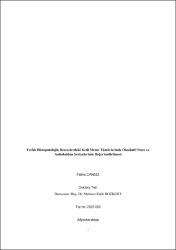Farklı histopatolojik derecelerdeki kedi meme tümörlerinde oksidatif stres ve antioksidan seviyelerinin değerlendirilmesi
Abstract
Bu çalışmada, Kuğulu Veteriner Polikliniği’ne teşhis ve tedavi amaçlı getirilen kedilere ait meme tümörü operasyon malzemelerine ait parafin doku kesitlerinde tümör mikro çevresi, immunohistokimyasal yöntemle belirlenerek oksidatif stresle ilişkisi araştırıldı. Organizmanın antioksidan cevap değerlendirildi ve bu sonuçların her bir derece tümörle ilişkisinin araştırılması amaçlandı. Bu amaçla tümör mikro çevresi CD3, nükleer faktör kappa beta (NF-Kß), CD31, vasküler endotelyal büyüme faktörü (VEGF), indüklenebilir nitrik oksit sentaz (iNOS), hipoksi ile indüklenebilir faktör 1 alfa (HIF-1α), tümör nekrotik faktör alfa (TNF-α) ve 8 hidroksiguanozin (8OHdG) antikorları kullanılarak immunohistokimyasal metot ile değerlendirilirken, total antioksadan statü (TAS), total oksidan statü (TOS), oksidatif stres indeksi (OSI), redükte glutatyon (GSH), melondialdehit (MDA), nitrik oksit (NO) ve katalaz (CAT) analizleri kan serumundan biyokimyasal olarak yapıldı.
Çalışmaya 17 meme tümörlü kedi dahil edildi. Kedilerin 6’sı derece 1, 5’i derece 2 ve 6’sı derece 3 tümör olarak teşhis edildi. Tümörlerin 11’i tubuler adenokarsinom, 3’ü tubulopapillar karsinom, 1’i papillar karsinom, 2’si solid karsinom olarak teşhis edildi. Vakaların yaş oratalamsı 10,7 olup, en çok etkilenen ırk tekirdi (n=12).
İmmunohistokimyasal analizlerde tüm antikorlar derece 3 tümörlerde daha yoğun olarak boyandı. Bu antikorların birbirleriyle olan ilişkileri derece 3 tümörlerde belirgin şekilde ortaya konuldu. Her bir antikor için derece 1 ve 2 tümörler arasında yoğun bir farklılık görülmedi. CD31 hariç diğer antikorlar açısından ise derece 3 ve 1 tümörler arasında boyanma yoğunluğu açısından önemli farklılık olduğu belirlendi. CD31 ise tüm kesitlerde hemen hemen eşit derecede boyandı.
Biyokimyasal analizlerde oksidatif stres belirteçleri sadece NO değerinde kontrol grubu ile tümör grupları arasında fark görülmezken, TOS, OSI ve MDA değerlerinde gruplar arasında fark belirlendi. MDA analizinde kontrol grubu ile derece 3 tümörler arasında belirgin fark olduğu görüldü. Organizmanın oksidatif stresle savaşma sistemi olan antioksidanlar açısından ise CAT, GSH ve TAS analizlerinde total antioksidan kapasitesinin kontrol grubu ile derece 3 tümörler, CAT analizinde kontrol grubu ile derece 1 tümörler arasında fark bulundu. GSH analizinde gruplar arasında fark olmadığı görüldü. Kimyasal analizlerde parametrelerin dereceler arasında anlamlı değişkenlik göstermediği bulundu.
Çalışma, oksidatif stresin tümör ve tümör mikro çevresini etkilemesi, tümör ve tümör mikro çevresinde birbiri ile ilişkili parametrelerin değerlendirilmesi açısından önemlidir. Çalışmada bakılan parametrelerin daha malign tümörlerde daha yoğun boyandığı belirlenmiştir. Bu çalışma Türkiye’de kedi meme tümörü ve tümör mikro çevresi ile ilgili yapılan en kapsamlı çalışmalardan biridir. Değerlendirilen parametrelerin artışı kötü prognozla ilişkili olmakla birlikte, bu parametreler kedi meme tümörlerinde hastalığa henüz tam olarak entegre edilememiştir. Hastalığın prognozu ve tedavi seçeneklerini etkilemeleri açısından çok daha geniş örneklem büyüklükleri ile çalışılmalı ve bu hastaların hepsi operasyon sonrasında da takip edilmelidir. In this study, the tumor microenvironment was determined by immunohistochemical method in paraffin tissue sections of mammary tumor operation materials belonging to cats brought to Kuğulu Veterinary Outpatient Clinic for diagnostic and therapeutic purposes and its relationship with oxidative stress was investigated. The antioxidant response of the organism was evaluated and it was aimed to investigate the relationship of these results with each degree of tumor. For this purpose, the tumor microenvironment was evaluated by immunohistochemical method using CD3, nuclear factor kappa beta (NF-Kß), CD31, vascular endothelial growth factor (VEGF), inducible nitric oxide synthase (iNOS), hypoxia-inducible factor 1 alpha (HIF-1α), tumor necrotic factor alpha (TNF-α) and 8 hydroxyguanosine (8OHdG) antibodies, while the total antioxidant status (TAS), total oxidative status (TOS), oxidative stress index (OSI), reduced glutathione (GSH), melondialdehyde (MDA), nitric oxide (NO) and catalase (CAT) analyses were performed biochemically from blood serum.
Seventeen cats with mammary tumor were included in the study. Six of the cats were diagnosed as grade 1, 5 as grade 2 and 6 as grade 3 tumors. Eleven of the tumors were diagnosed as tubular adenocarcinoma, 3 as tubulopapillary carcinoma, 1 as papillary carcinoma, 2 as solid carcinoma. The avarage age of the cases was 10.7 and the most affected breed was tekir (n=12).
In immunohistochemical analyses, all antibodies were stained more intensively in grade 3 tumors. The relationships of these antibodies to each other were clearly revealed in grade 3 tumors. There was no significant difference between grade 1 and 2 tumors for each antibody. In terms of antibodies other than CD31, it was determined that there was a significant difference in staining intensity between grade 3 and 1 tumors. CD31, on the other hand, was painted almost equally in all sections.
In biochemical analyzes, there was no difference between the control and tumor groups in oxidative stress markers only in NO values, but there was a difference between the groups in TOS, OSI and MDA values. In MDA analysis, there was a significant difference between the control group and grade 3 tumors. In terms of antioxidants, which are the body's system for fighting oxidative stress, a difference was found between the control group and grade 3 tumors of total antioxidant capacity in CAT, GSH and TAS analyses, and between the control group and grade 1 tumors in CAT analysis. There was no difference between the groups in GSH analysis. In chemical analysis, it was found that the parameters did not show significant variability between grades.
The study is important in terms of the effect of oxidative stress on the tumor and tumor microenvironment, and the evaluation of interrelated parameters in the tumor and tumor microenvironment. It was determined that the parameters examined in the study were stained more intensely in more malignant tumors. This study is one of the most comprehensive studies on feline mammary tumors and tumor microenvironment in Turkey. Although increased parameters evaluated are associated with poor prognosis, these parameters have not yet been fully integrated into the disease in feline mammary tumors. They should be studied with much larger sample sizes in terms of their impact on the prognosis of the disease and treatment options, and all of these patients should be followed up after the operation.
Collections
- Doktora Tezleri [161]



















